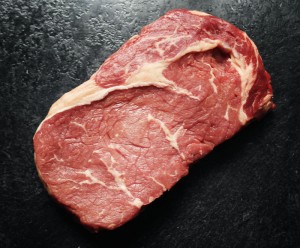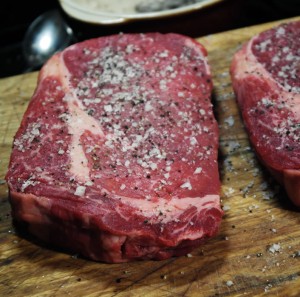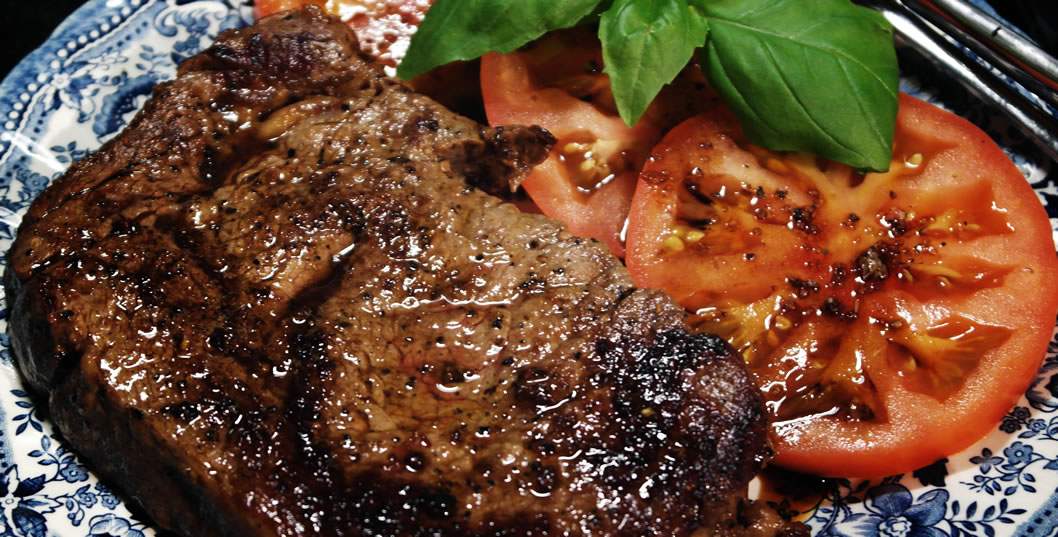The rib eye steak is cut from one of the fore ribs of the animal and, in the UK, is usually off the bone.
The part of the rib cage that the steak is from doesn’t carry much of the animals weight and so is a lightly worked muscle making it tender and with a good fat content.
 A great rib eye steak needs to be at least an inch thick, dry aged and with plenty of fat. Keeping to a big thick steak allows for the formation of a good “crust” on the outside with all the associated flavour whilst retaining some moisture in the centre. The fat content is what gives the rib eye it’s flavour and comes from the meat itself as well as the surrounding tissue. There should be a good marbling of fat running through the meat and a nice thick block of fat at one end of the steak.
A great rib eye steak needs to be at least an inch thick, dry aged and with plenty of fat. Keeping to a big thick steak allows for the formation of a good “crust” on the outside with all the associated flavour whilst retaining some moisture in the centre. The fat content is what gives the rib eye it’s flavour and comes from the meat itself as well as the surrounding tissue. There should be a good marbling of fat running through the meat and a nice thick block of fat at one end of the steak.
Cooking Your Rib Eye Steak
Rib eyes are best when cooked for a little longer than other steaks to make the most of breaking down the fat and infusing the flavour into the meat.
Although you can cook rib eyes on the BBQ grill there are some disadvantages to losing that marvellous fat content and flavour to the flames and heat. Cooking in a good old fashioned cast iron frying pan will allow the steak to cook in it’s own juices and absorb the flavour from the fat.
 Find a good quality dry aged steak. I’m a big fan of letting the quality of the meat speak for itself and just seasoning with salt and pepper. If you’re happy with the quality and age of your steak, then bring it out of the fridge and allow it to come to room temperature for at least an hour before cooking, this allows the chill to leave the meat. Then season it with sea salt & pepper just before hitting the pan. If you have reason to believe that the steak hasn’t been dry aged, then you could add some salt when you first bring it out of the fridge and allow it to sit for 45 minutes, this will have the effect of drawing the moisture out of the steak and creating it’s own brine. This will be absorbed back into the steak and have a tenderising effect.
Find a good quality dry aged steak. I’m a big fan of letting the quality of the meat speak for itself and just seasoning with salt and pepper. If you’re happy with the quality and age of your steak, then bring it out of the fridge and allow it to come to room temperature for at least an hour before cooking, this allows the chill to leave the meat. Then season it with sea salt & pepper just before hitting the pan. If you have reason to believe that the steak hasn’t been dry aged, then you could add some salt when you first bring it out of the fridge and allow it to sit for 45 minutes, this will have the effect of drawing the moisture out of the steak and creating it’s own brine. This will be absorbed back into the steak and have a tenderising effect.
You shouldn’t need to use oil, but if you’re worried about sticking to the pan, Yorkshire rapeseed oil is a great choice for cooking your steak as it has a high smoking and burn point, add some massaged into the steak just before hitting the hot pan, rather than adding it to the pan itself. This will give you a great maillard (the crust) on the steak without the need to open all your kitchen windows.
Get your pan really hot before adding your steak. A good test is to hold your hand just above the pan. It should be too painful to bear if your pan is hot enough.
When your pan is hot enough, make sure the steak is dry on the outside and then season well with sea salt and freshly ground black pepper.
Add the steak to the pan and allow it to sit for a couple of minutes before turning it. Don’t be tempted to move the pan around, it’s important that the steak makes contact with the pan to form the crust we’re looking for. Turn the steak every couple of minutes, moving it to a new area of the pan, until you’ve reached perfection.
Give the steak enough time to cook and render the fat rather than going for a cheffy rare steak, that’s great with some other lean steaks like fillet, but your rib eye deserves a slower pace and more care. An inch thick rib eye probably needs 6 – 8 minutes in total for medium. If you’re fanatical about it, the internal temperature should be around 68 C when it leaves the pan for a medium steak, which will make it around 70 c when it’s been rested.
In the final minute of cooking your steak add plenty of good quality grass fed butter to the pan and spoon it over the steak to baste it. Remove the steak from the pan and allow it to rest for 10 minutes.


No comments yet.